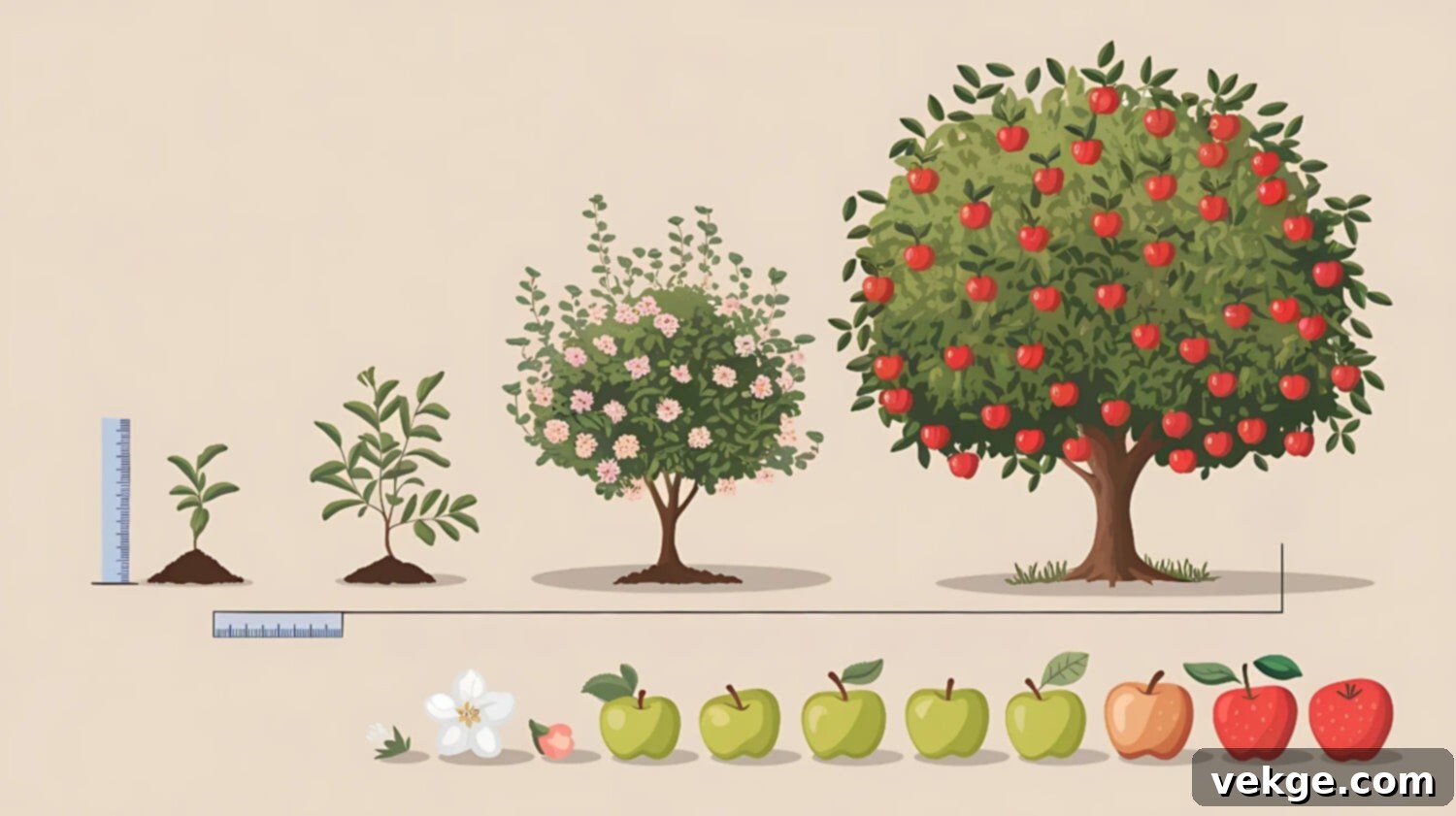Your Comprehensive Guide to Growing Apple Trees: From Planting to Bountiful Harvest
There’s a unique satisfaction in harvesting fresh, crisp apples from your own backyard. The journey from a young sapling to a tree laden with ripe fruit is a rewarding experience, filled with anticipation and essential learning. This comprehensive guide will equip you with all the knowledge you need to successfully cultivate apple trees, transforming your garden into a productive orchard.
Many aspiring growers often ask, “How long does it take for an apple tree to bear fruit?” The answer, as you’ll discover, depends on several factors, including the tree type, specific variety, local growing conditions, and the care it receives. We’ll delve into these crucial elements, guiding you through selecting the ideal apple tree, preparing its environment, and nurturing it through every stage of growth. Let’s embark on your path to apple abundance!
The Ideal Climate and Conditions for Thriving Apple Trees
Apples are remarkably adaptable and cultivated in diverse regions worldwide. However, they flourish under specific climatic and environmental conditions. Understanding these optimal requirements is fundamental for ensuring robust growth and a prolific harvest.
1. Hardiness Zones: Understanding Temperature Tolerance
Apple trees generally thrive in USDA Hardiness Zones 3 to 8. These zones classify regions based on their average annual minimum winter temperatures, indicating which plants are most likely to survive in a given location. Specific varieties, however, have different preferences:
- “Hardy” varieties: These are best suited for colder climates, typically Zones 3 to 5, where they can withstand more severe winter temperatures.
- “Long-season” varieties: These perform better in milder climates, generally Zones 5 to 8, needing a longer growing season to fully mature their fruit.
Before planting, it’s essential to identify your specific hardiness zone and select apple varieties accordingly. Choosing a tree well-suited to your climate significantly increases its chances of survival and fruit production.
2. Temperature Requirements: The Importance of Chill Hours
Apple trees require a period of winter chilling for proper fruit set. This is measured in “chill hours,” which represent the cumulative number of hours the temperature remains between 32°F and 45°F (0°C to 7°C) during dormancy. Without adequate chill, trees may fail to bud, produce sparse blooms, or yield little to no fruit.
- Most common apple varieties need between 500 and 1,000 chill hours.
- Some specialized low-chill varieties can produce fruit with as little as 300 chill hours, making them suitable for warmer climates.
Generally, apple varieties grown in northern regions tend to require more chill hours to prevent premature budding, which can make them vulnerable to late spring frosts.
3. Soil Conditions: Foundations for Healthy Roots
Apple trees prefer well-drained, fertile soil with a slightly acidic to neutral pH. Proper soil conditions ensure that roots can access essential nutrients and oxygen while preventing waterlogging.
- Ideal soil pH: 6.0 to 6.5, which optimizes nutrient availability.
- Acceptable pH range: 5.5 to 7.0. Soil tests can help you determine your current pH and guide amendments.
Light to medium-textured soils, such as loams, are ideal. Heavy clay soils, on the other hand, can lead to poor drainage and increase the risk of root rot. If you have heavy clay, it should be amended with organic matter like compost to improve its structure and drainage before planting.
4. Sunlight Needs: Fueling Fruit Development
Apple trees are sun-lovers and require ample light for robust growth and fruit production. Without sufficient sunlight, trees may become leggy, produce fewer flowers, and yield smaller, less flavorful fruit.
- They require full sun exposure.
- Aim for at least 6 to 8 hours of direct sunlight daily, especially during the growing season.
Adequate sunlight is critical for photosynthesis, which converts light energy into sugars essential for fruit development, optimal flavor, and vibrant color.
5. Air Circulation: A Natural Disease Preventative
Good air circulation is vital for apple trees, primarily to mitigate the risk of fungal diseases. Stagnant, humid air around foliage creates an ideal environment for pathogens to thrive.
- It helps reduce the incidence of fungal diseases like apple scab and powdery mildew.
- It allows leaves to dry quickly after rain or irrigation, further preventing fungal issues.
Plant trees in a location with natural airflow, avoiding enclosed spaces or low-lying areas where cold, damp air tends to settle. Proper spacing between trees also contributes to good air circulation.
6. Water Requirements: Consistent Moisture for Growth
While established apple trees exhibit some drought tolerance, they perform best and produce higher-quality fruit with consistent moisture throughout the growing season.
- Aim for about 1 inch of water per week, either from rainfall or irrigation.
- Newly planted trees require more frequent watering to establish their root systems.
Proper irrigation is particularly crucial during bud break, flowering, and especially during fruit development, as water directly impacts fruit size and juiciness. A layer of mulch around the base of the tree can help retain soil moisture and regulate temperature.
By carefully considering these climatic and environmental factors, you can create an optimal growing environment for your apple trees, laying the groundwork for healthy growth and consistently bountiful harvests.
Apple Tree Varieties: Choosing Your Perfect Match
When planning your home orchard or selecting a single tree for your backyard, understanding the different types of apple trees available is paramount. The three primary types – dwarf, semi-dwarf, and standard – differ significantly in size, the time it takes to bear fruit, and their overall lifespan. Each type is grafted onto a specific rootstock that dictates its ultimate size and vigor. Let’s explore each in detail to help you choose the best fit for your needs.
1. Dwarf Apple Trees: Compact and Early Bearing
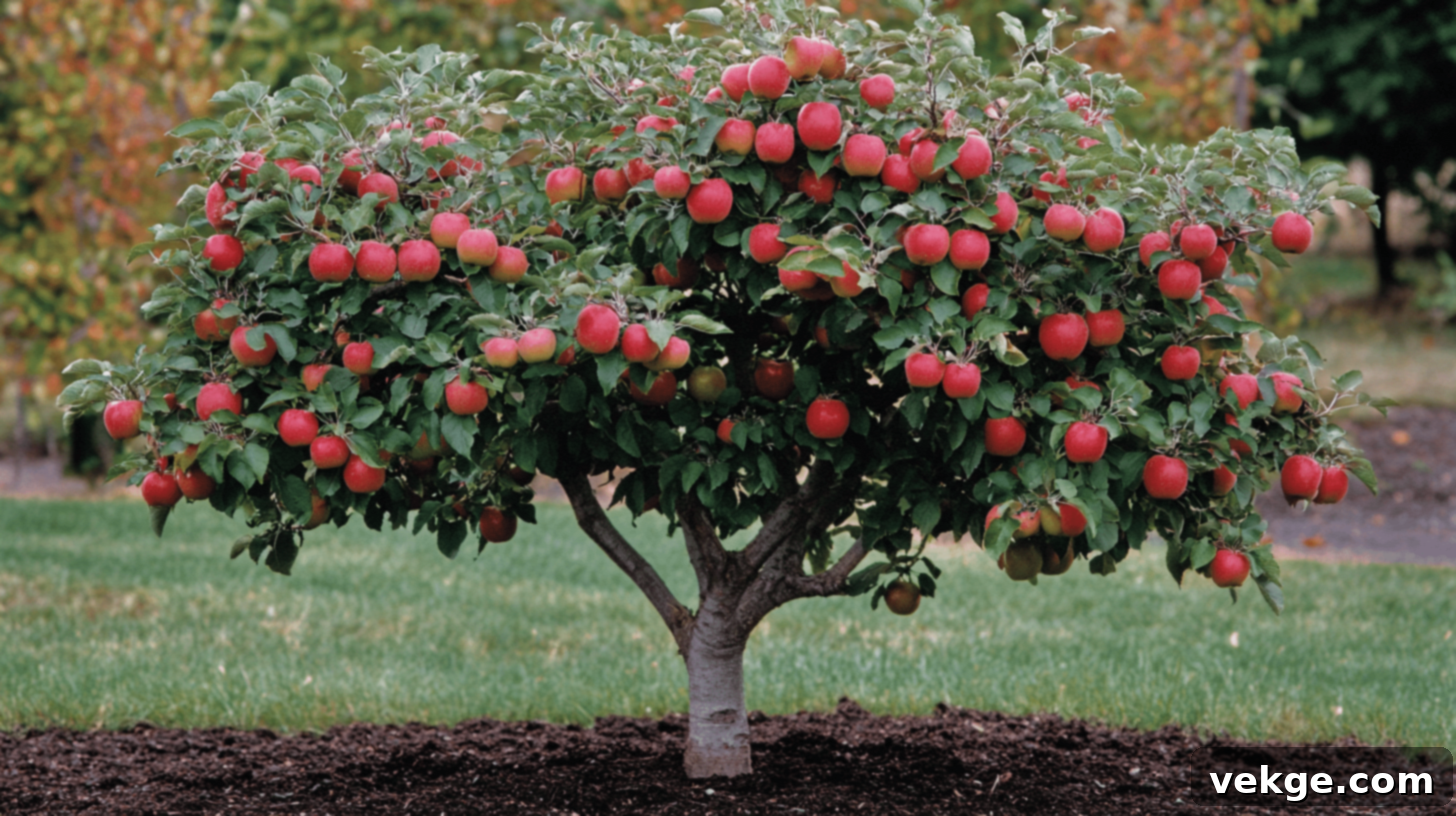
Dwarf apple trees are an excellent choice for small gardens, urban spaces, or for gardeners who prioritize quick fruit production and easy management. Their smaller size is achieved by grafting scion wood onto a dwarfing rootstock.
Characteristics:
- Height: Typically 8-10 feet tall at maturity, making them manageable without ladders.
- Spread: Usually 8-10 feet wide, requiring less horizontal space.
- Time to Fruit: Begin fruiting relatively quickly, often within 2-3 years after planting.
- Lifespan: Generally 15-20 years, a shorter lifespan compared to larger varieties.
Advantages:
- Space-Saving: Perfect for small yards, container gardening, or espalier training.
- Easy Management: Pruning, harvesting, and pest inspection are much simpler due to their compact size.
- Early Production: You’ll enjoy your first apples much sooner than with larger trees.
- High-Density Planting: Allows you to grow multiple varieties in a limited area.
Considerations:
- Staking Required: Due to their smaller root systems, dwarf trees often require permanent staking or support to remain upright, especially when laden with fruit or in windy conditions.
- Lower Overall Yield: While they fruit early, the total volume of fruit produced over their lifetime is less than that of larger trees.
- Less Hardy: May be more susceptible to extreme weather conditions and require more protection in very cold climates.
2. Semi-Dwarf Apple Trees: The Balanced Choice
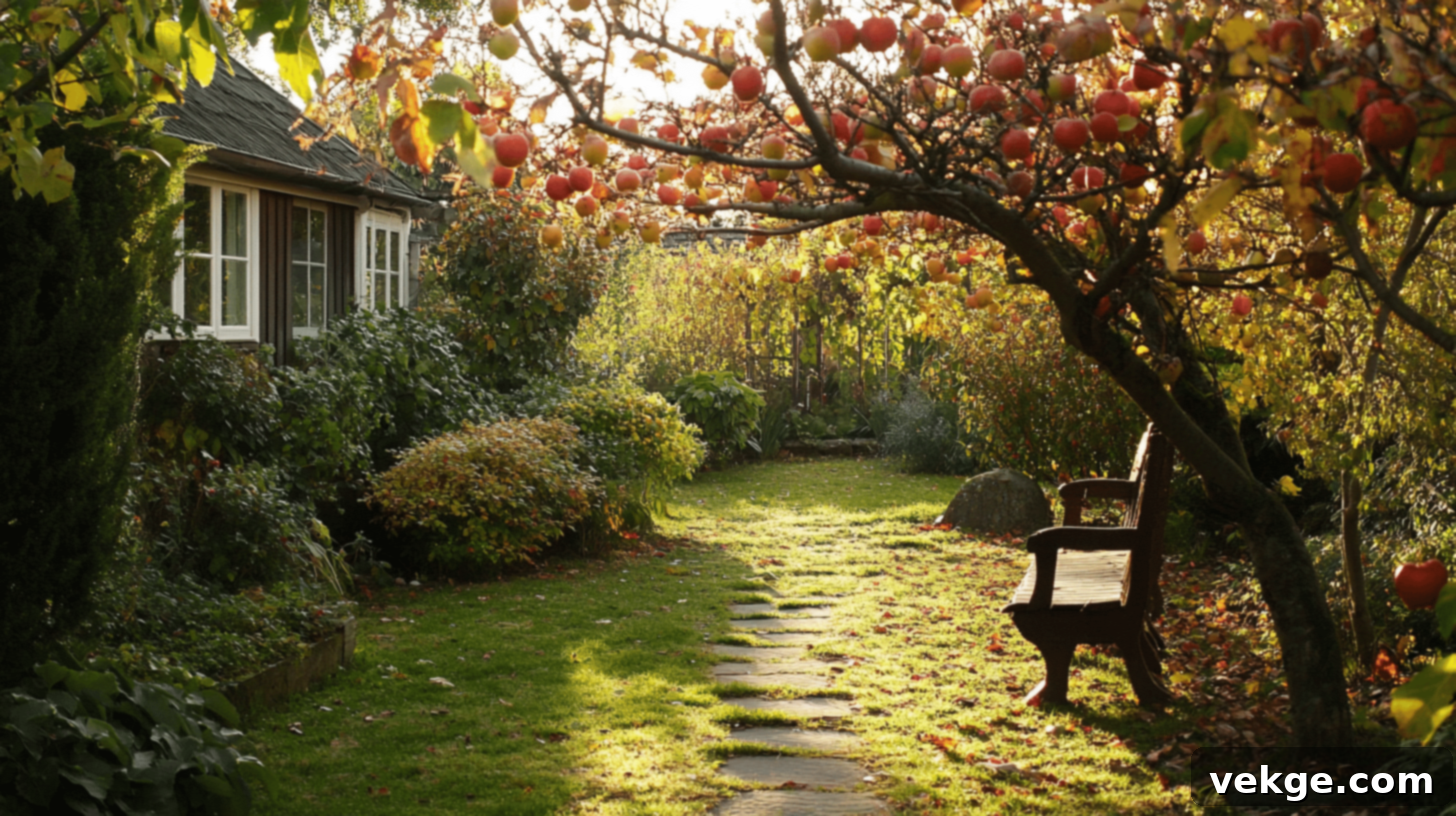
Semi-dwarf trees strike a desirable balance between the compact size of dwarfs and the robust nature of standard trees. They are a popular choice for many home gardeners, offering a good compromise between space requirements and fruit production.
Characteristics:
- Height: Usually 12-15 feet tall at maturity.
- Spread: Typically 12-15 feet wide.
- Time to Fruit: Start fruiting within 3-5 years after planting.
- Lifespan: Approximately 20-25 years, offering a good period of productivity.
Advantages:
- Good Balance: Offers a satisfying yield without requiring the extensive space of a standard tree.
- More Stable: Generally possess stronger root systems than dwarf trees and often do not require permanent staking.
- Manageable Size: Easier to prune, spray, and harvest compared to standard trees, though a small ladder may be needed for upper branches.
- Adaptability: Well-suited for a variety of garden sizes.
Considerations:
- Space Needs: Require more garden space than dwarf trees, so plan accordingly.
- Harvesting: You may need a step stool or small ladder for pruning and harvesting fruit from the higher branches.
3. Standard Apple Trees: Traditional and Long-Lived
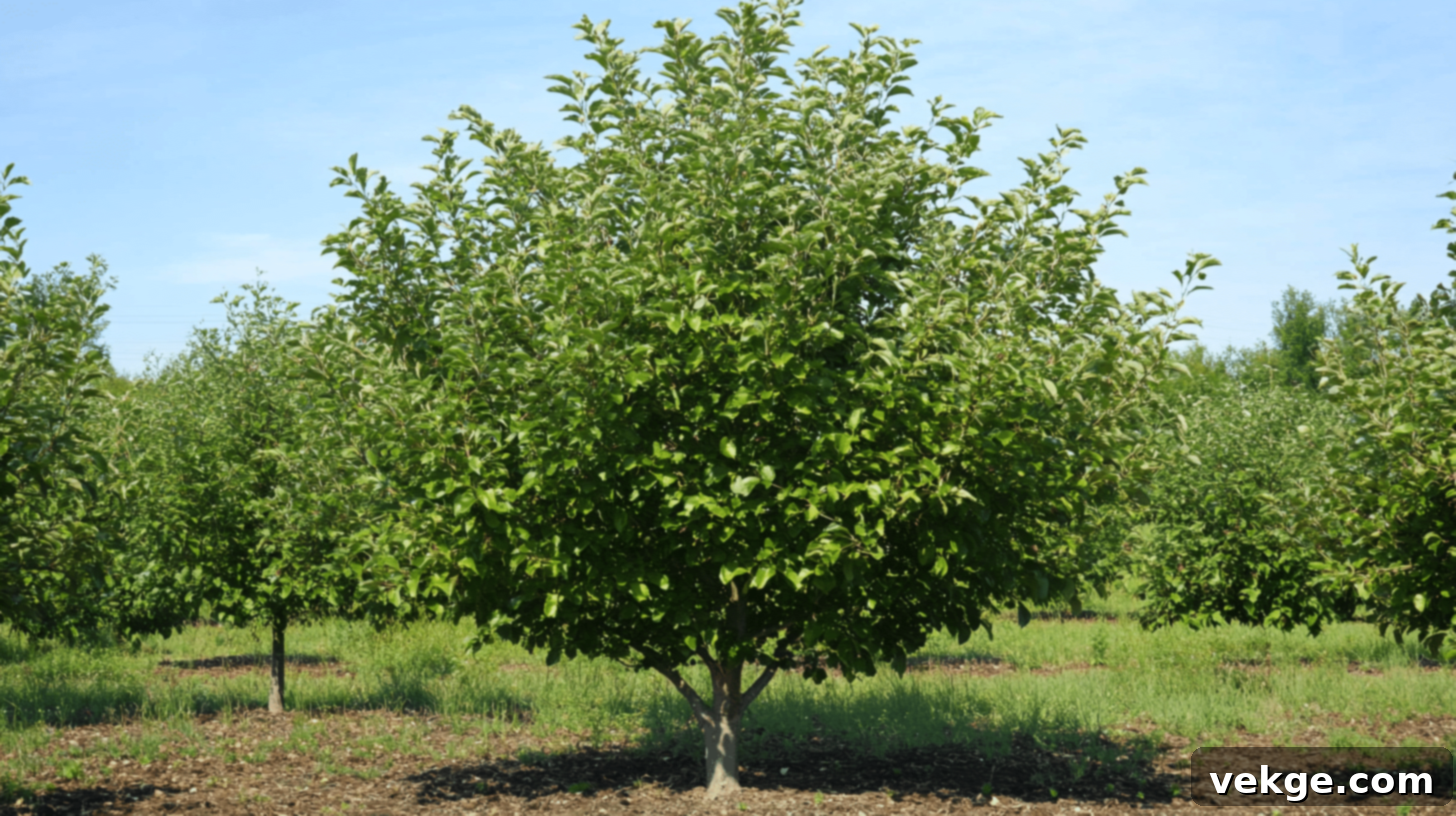
Standard apple trees are the traditional, full-sized trees often seen in older orchards. They are grafted onto vigorous rootstock, resulting in large, robust trees that are highly productive and long-lived.
Characteristics:
- Height: Can grow 18-25 feet tall or more, depending on the variety and conditions.
- Spread: Often 15-25 feet wide, casting significant shade.
- Time to Fruit: Take the longest to mature, typically 4-8 years to begin bearing fruit.
- Lifespan: Can live and produce for 50 years or even more with proper care, becoming a lasting legacy.
Advantages:
- Highest Yield: Produce the most fruit per tree, making them ideal for large-scale production or supplying a big family.
- Very Hardy: Extremely robust and long-lived, offering excellent resistance to environmental stresses.
- Deep Root Systems: Their extensive root systems make them more drought-resistant once established.
- Shade and Aesthetics: Provide substantial shade and contribute significantly to landscape aesthetics.
Considerations:
- Significant Space Required: Demand considerable garden space, making them unsuitable for small yards.
- Challenging Management: Pruning, spraying, and harvesting require tall ladders or specialized equipment, making maintenance more labor-intensive.
- Late Fruiting: Patience is key, as it takes many years before the first harvest.
- Not for Containers: Entirely unsuitable for container gardening.
When making your selection, carefully consider your available garden space, how quickly you wish to enjoy fruit, and your long-term commitment to tree maintenance. Each apple tree type offers distinct advantages, and the optimal choice will depend entirely on your individual needs and gardening aspirations.
Can You Grow Apples from Seeds? Understanding the Genetic Lottery
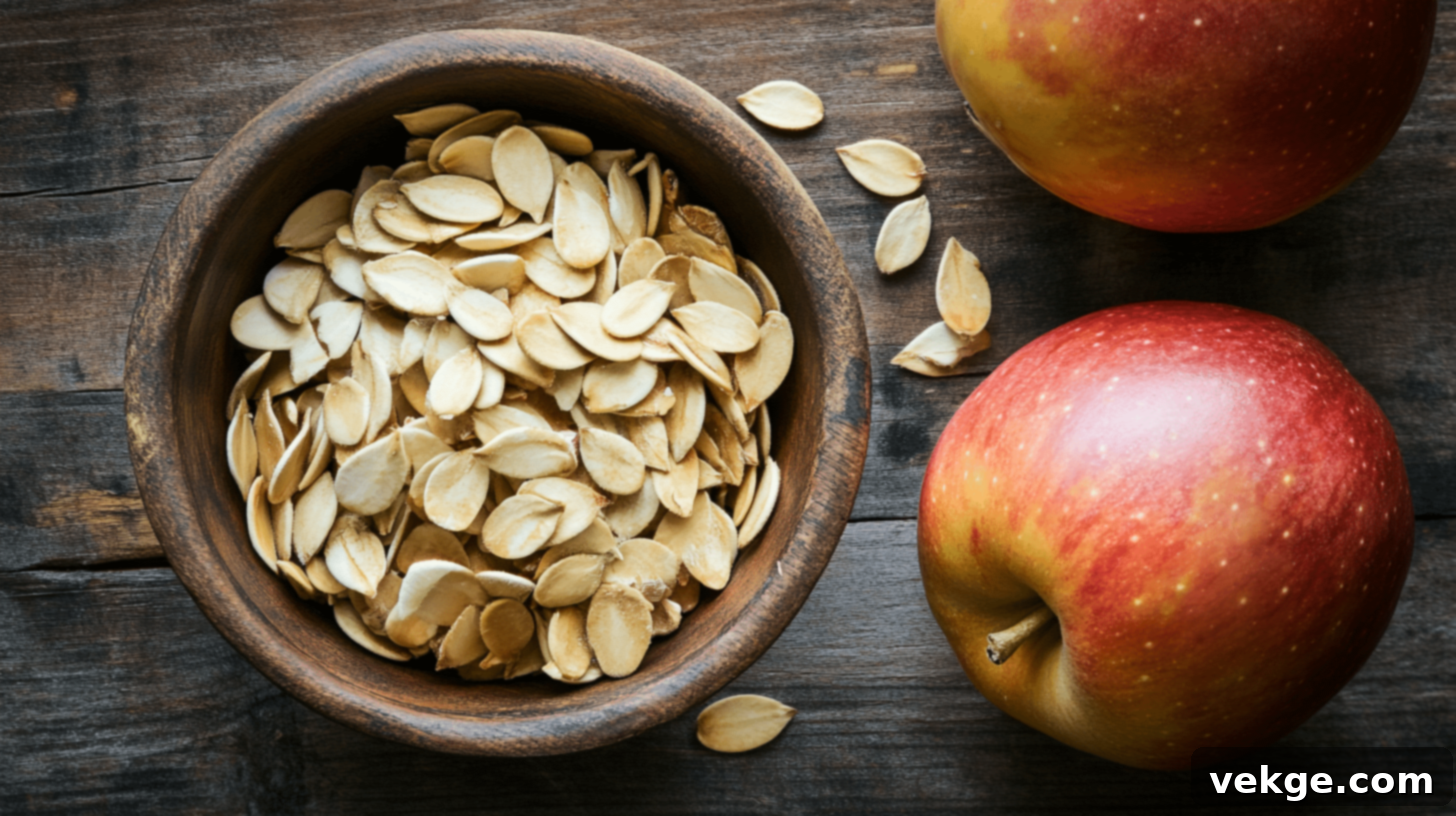
Many home gardeners are curious about growing apple trees from the seeds found in their favorite fruits. While technically possible, growing an apple tree from seed is often referred to as a “genetic lottery” because the results are highly unpredictable and rarely produce a tree identical to the parent fruit. Let’s explore the process, its advantages, and its significant drawbacks.
The Process of Growing Apples from Seeds
If you’re interested in a fun experiment, here’s the general process:
- Seed Extraction: Carefully remove seeds from a ripe, healthy apple.
- Cleaning: Clean the seeds thoroughly, removing all fruit flesh and debris to prevent mold.
- Stratification: Apple seeds require a period of cold dormancy to germinate. Mimic winter conditions by placing seeds in a moist medium (like damp paper towel or peat moss) inside a sealed plastic bag in the refrigerator for 70-80 days. This “cold stratification” tricks the seed into thinking winter has passed.
- Germination: After stratification, plant the seeds about 1/2 inch deep in pots filled with well-draining potting soil. Place in a warm location and keep the soil consistently moist.
- Transplanting: Once seedlings are sturdy enough and all danger of frost has passed, they can be hardened off and eventually transplanted outdoors.
Pros of Growing Apples from Seed
- Educational Experience: It’s a fantastic learning opportunity, especially for children, to understand plant life cycles.
- Potential for Novelty: You might, by pure chance, discover a new, unique apple variety. However, the odds are extremely low.
- Cost-Effective: It’s a free way to grow trees, assuming you have the patience and space.
Cons of Growing Apples from Seed: The Significant Drawbacks
- Long Wait for Fruit: Seed-grown trees typically take 6-10 years, or even longer, to produce their first fruit. This is significantly longer than grafted trees.
- Uncertain Fruit Quality: The most significant drawback is that the fruit produced will almost certainly not be identical to the parent apple. It may be smaller, less flavorful, or have undesirable textures. Apple genetics are complex, and the resulting tree is a cross of its parents, not a clone.
- Unsuitable Fruit: Many seed-grown apple trees produce fruit that is not palatable for eating raw and is only suitable for cider or even wildlife.
- Variable Tree Characteristics: The tree itself may have unpredictable growth habits, disease susceptibility, and overall vigor that may not be well-adapted to your local climate or desired form.
- Lack of Rootstock Benefits: Seedlings grow on their own roots, lacking the benefits of specific rootstocks that control tree size, disease resistance, and precocity (early fruiting).
Time to Fruit Production: Seed vs. Grafted
- Seed-grown trees: Usually take 6-10 years or more to produce fruit.
- Grafted trees from nurseries: Can produce fruit in 2-5 years, depending on the rootstock used (dwarf rootstocks fruit earliest).
The Reliable Alternative: Buying Grafted Saplings from Nurseries
For reliable results and quicker fruit production, most gardeners choose to purchase young, grafted apple trees from reputable nurseries. This is highly recommended because:
- Predictable Results: Trees are grafted onto specific rootstocks for predictable size (dwarf, semi-dwarf, standard) and consistent fruit quality.
- Known Varieties: You know exactly what apple variety you are getting, selected for its taste, disease resistance, and suitability for your climate.
- Earlier Fruiting: Grafted trees mature and bear fruit much sooner, often within just a few years.
- Disease Resistance: Many modern rootstocks offer enhanced resistance to common apple diseases, leading to healthier trees.
While growing apples from seed can be a fascinating educational project, purchasing young, grafted trees from a reputable nursery is the practical and recommended approach for anyone serious about harvesting delicious apples within a reasonable timeframe.
Preparing for Success: When and Where to Plant Your Apple Tree

The success of your apple tree starts with proper planning: choosing the right time and location for planting. These decisions significantly impact the tree’s establishment, health, and future productivity.
Optimal Planting Windows for Apple Trees
The best time to plant depends largely on your local climate and the type of tree you purchase (bare-root vs. container-grown).
- Spring Planting:
- Generally considered the best for colder climates (USDA zones 1-5).
- Plant as soon as the ground is workable and the danger of severe frost has passed.
- This allows the tree ample time to establish its root system before the stresses of winter.
- Fall Planting:
- Ideal for milder climates (USDA zones 6-10).
- Plant approximately 6 weeks before the ground typically freezes.
- The cooler temperatures and consistent moisture of fall allow roots to establish without the stress of summer heat, positioning the tree for vigorous spring growth.
- Bare-root Trees:
- These dormant trees, sold without soil around their roots, should always be planted in early spring while they are still dormant, before bud break.
- They are highly sensitive to drying out, so plant them quickly after purchase.
- Container-grown Trees:
- Offer the most flexibility and can be planted throughout the growing season, from spring to fall.
- If planting during summer, ensure diligent and adequate watering to prevent transplant shock.
Choosing the Perfect Spot for Your Apple Tree
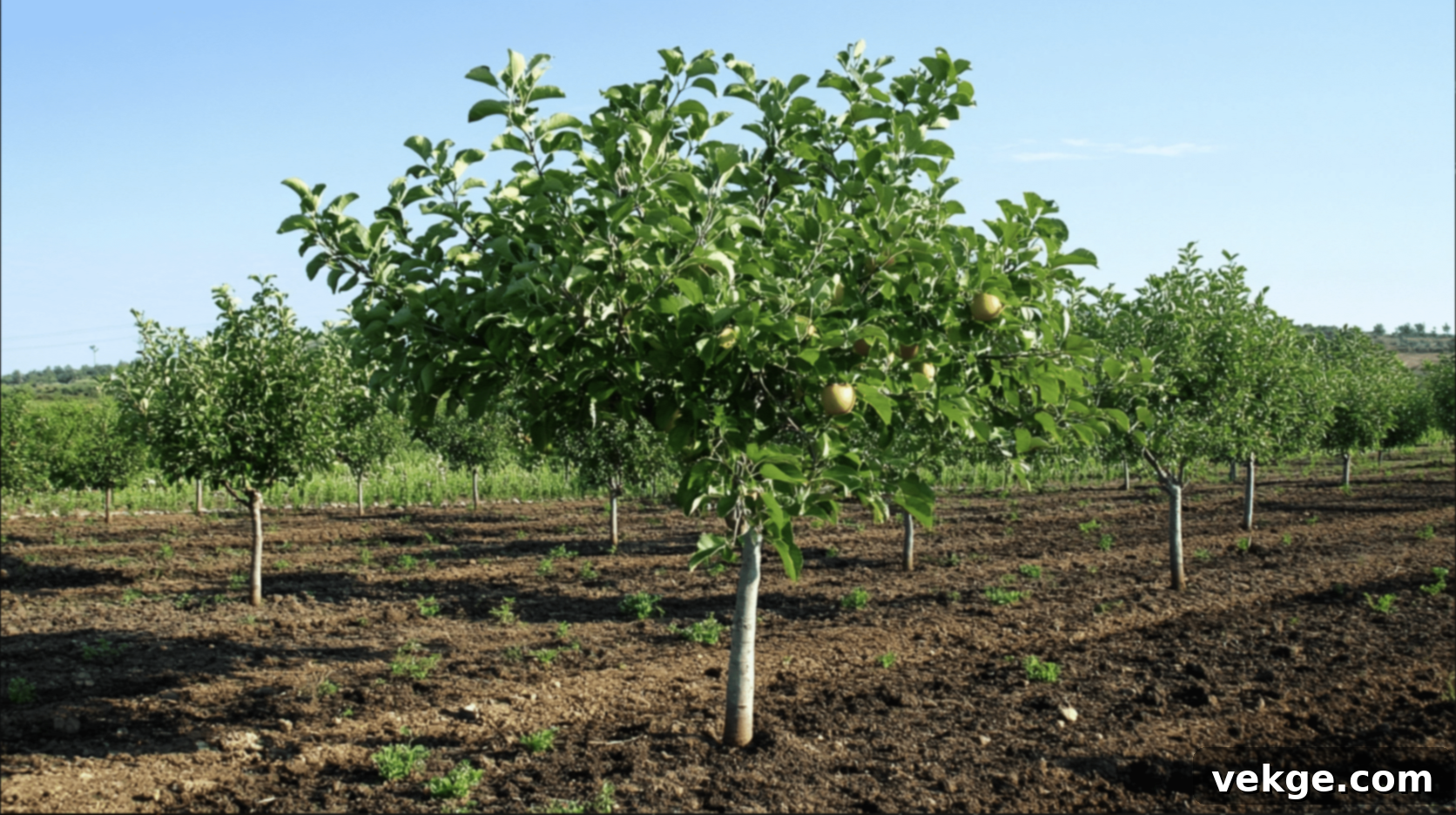
The location you choose is paramount for the long-term health, productivity, and vigor of your apple trees. A well-chosen site provides the essential resources a tree needs to thrive.
- 1. Sunlight Requirements:
- Select a site with full sun exposure, meaning 6-8 hours of direct sunlight daily.
- Morning sun is particularly beneficial as it helps to quickly dry dew from leaves, significantly reducing the risk of fungal diseases.
- 2. Soil Conditions:
- Ensure the soil is well-draining. Apple tree roots dislike sitting in soggy conditions, which can lead to root rot.
- Aim for a slightly acidic to neutral pH (6.0-7.0). Conduct a soil test to confirm your soil’s pH and nutrient levels.
- Avoid heavy clay soils or amend them substantially with organic matter (compost, aged manure) to improve drainage and aeration.
- 3. Air Circulation:
- A location with good airflow is crucial for preventing disease.
- Avoid planting in low-lying areas or “frost pockets” where cold, heavy air settles, as this can increase susceptibility to frost damage and fungal issues.
- 4. Spacing:
- Proper spacing between trees and other structures is vital for mature tree health and light penetration.
- Dwarf trees: Plant 8-10 feet apart.
- Semi-dwarf trees: Plant 12-15 feet apart.
- Standard trees: Require ample space, typically 20-25 feet apart.
- 5. Protection:
- Choose a site that offers some shelter from strong, damaging winds, which can break branches or cause fruit drop.
- Avoid areas prone to severe frost, as mentioned with air circulation.
- 6. Water Access:
- Plant your tree relatively close to a water source to facilitate easy and consistent irrigation, especially during dry periods and for young trees.
- 7. Future Growth Considerations:
- Always account for the mature size of the tree. Avoid planting too close to buildings, fences, utility lines, septic systems, or other trees that might compete for resources or be damaged by roots.
- 8. Pollination:
- Most apple varieties require cross-pollination from a different, compatible apple variety to produce fruit. Ensure you plant at least two different, compatible varieties within 50 feet of each other for successful pollination. Some varieties are self-fertile but still yield more with a pollinator.
By carefully considering both the timing and location for planting your apple trees, you will provide them with the strongest possible start, setting the stage for healthy growth and years of delicious, bountiful harvests.
Planting Apple Seeds Successfully: A Detailed Experimental Guide

While we’ve discussed that growing apple trees from seeds isn’t the most practical or reliable way to produce edible fruit, it remains an intriguing and highly educational project. If you’re keen to embark on this genetic adventure, here’s a step-by-step guide on how to plant apple seeds successfully.
Step 1: Obtain and Prepare Seeds
The quality of your seeds can impact germination rates, so start with healthy, mature apples.
- Choose Ripe Apples: Select fully ripe apples from a variety you find appealing, understanding that the offspring will likely not be identical.
- Extract Seeds: Carefully cut the apples and remove the seeds. Avoid damaging them with your knife.
- Clean Seeds: Thoroughly clean the seeds to remove any remaining fruit flesh or sugar. This is crucial as fruit residue can encourage mold growth during stratification. A gentle scrub under running water or soaking them for a day and then scrubbing can help.
Step 2: Stratification – Mimicking Winter Conditions
Apple seeds require a period of cold, moist dormancy to break their natural dormancy and initiate germination. This process, called stratification, mimics the natural conditions they would experience over winter.
- Dampen a Medium: Dampen a paper towel, a small amount of peat moss, or sand. It should be moist, but not soaking wet (no dripping water).
- Place Seeds: Place the cleaned seeds on the damp medium. For a paper towel, fold it over to cover the seeds.
- Seal and Label: Place the damp medium with seeds into a sealable plastic bag or an airtight container. Label the bag with the date and the apple variety (if known).
- Refrigerate: Store the sealed bag in the refrigerator (at temperatures between 35°F and 45°F / 1°C to 7°C) for 70-80 days. Check periodically to ensure the medium remains moist and there’s no mold growth. If mold appears, rinse the seeds, replace the medium, and use a fresh bag.
Step 3: Germination – Sprouting Your Seeds
After their cold slumber, the seeds are ready to sprout when provided with warmth and moisture.
- Remove from Refrigerator: After the stratification period, carefully remove the seeds. You might even notice some seeds have already begun to sprout in the bag!
- Prepare Pots: Fill small pots or seed-starting trays with a high-quality, well-draining potting mix. Peat pots or biodegradable seed-starting cells are excellent choices.
- Plant Seeds: Plant each seed about 1/2 inch deep in the soil. If multiple seeds are in one pot, ensure they are spaced adequately.
- Water Gently: Water the pots gently but thoroughly, ensuring the soil is moist but not waterlogged.
- Provide Warmth: Place the pots in a warm location, ideally around 70°F (21°C). A sunny windowsill or a grow light setup works well.
- Maintain Moisture: Keep the soil consistently moist but never soggy, which can lead to damping-off disease.
Step 4: Seedling Care – Nurturing Young Plants
Once your apple seedlings emerge, they’ll need attentive care to grow strong.
- Provide Light: Once seedlings emerge (which can take 2-4 weeks), ensure they receive abundant light. If natural light is insufficient, use grow lights to prevent them from becoming leggy.
- Water Regularly: Continue to water regularly, allowing the top layer of soil to dry slightly between waterings.
- Thinning (if necessary): If you have multiple seedlings in one pot, thin them to the strongest one by snipping weaker ones at the soil line.
- Repotting: When seedlings are 3-4 inches tall and have developed a few sets of true leaves, transplant them to larger pots (e.g., 1-gallon size) if necessary to allow for further root development.
Step 5: Transplanting Outdoors – Moving to Their Permanent Home
Transitioning seedlings from indoors to outdoors requires a gradual acclimation process.
- Harden Off: Over a period of 7-10 days, gradually expose your seedlings to outdoor conditions (sun, wind, varying temperatures). Start with a few hours in a sheltered, shady spot and slowly increase exposure. This process is called “hardening off” and prevents transplant shock.
- Choose a Suitable Location: Select a suitable planting location in your garden that meets all the requirements discussed in the “Choosing the Perfect Spot for Your Apple Tree” section (full sun, well-draining soil, good air circulation, pollination considerations, etc.).
- Prepare the Hole: Dig a hole that is twice as wide as the seedling’s root ball and deep enough so the top of the root ball is level with the surrounding soil.
- Plant the Seedling: Carefully remove the seedling from its pot, gently loosen any circling roots, and place it in the center of the hole. Ensure it’s planted at the same depth it was growing in the pot.
- Water and Mulch: Backfill the hole with soil, gently firming it around the roots to remove air pockets. Water thoroughly immediately after planting. Apply a 2-4 inch layer of organic mulch (like wood chips or straw) around the base of the tree, keeping it a few inches away from the trunk.
Growing apple trees from seeds is a deeply satisfying, long-term project that demands patience and curiosity. While it may not be the most practical method for consistent fruit production, it offers an unparalleled opportunity to learn about plant genetics, tree development, and the wonders of nature.
Apple Tree Development: A Yearly Breakdown from Sapling to Harvest
Understanding the distinct growth stages of an apple tree helps you anticipate its needs and provide appropriate care as it matures. The timeline for fruit production varies significantly with the chosen rootstock, with dwarf trees bearing fruit much earlier than standard varieties. Here’s a general year-by-year breakdown of an apple tree’s development:
Year 1: Seedling or Sapling Establishment
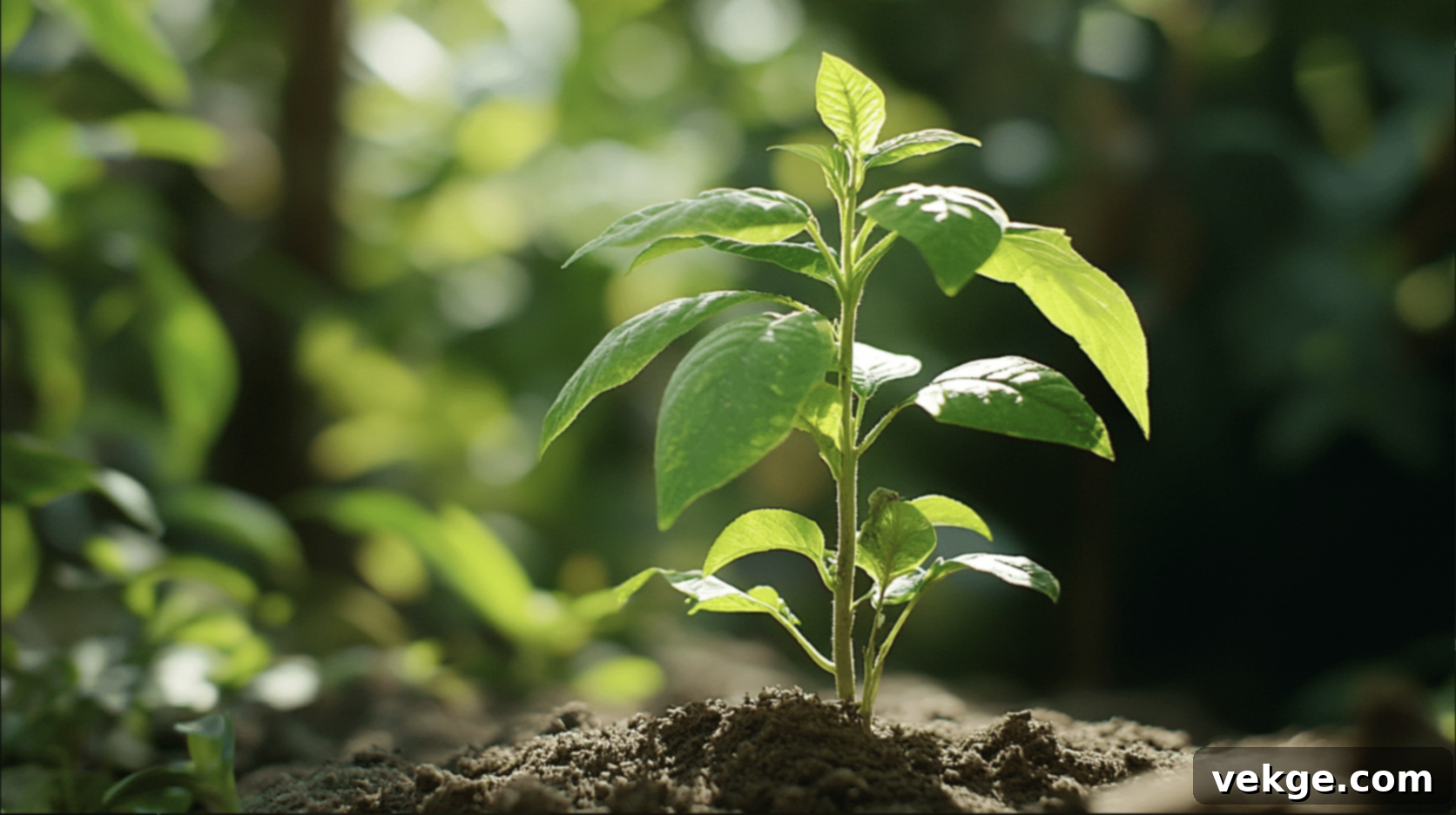
The primary focus during the first year is establishing a strong root system, whether the tree started as a tiny seedling or a nursery sapling.
- If grown from seed: This year sees the germination of your apple seed and the emergence of a small, tender seedling. Growth is slow and delicate.
- If planted as a sapling: The tree dedicates most of its energy to developing a robust network of roots to anchor itself and absorb water and nutrients from the soil. You might see some minor leaf growth, but above-ground development is secondary.
- Care Focus: Consistent watering is paramount. Protect the young tree from pests, diseases, and weed competition. Minimal pruning, if any, is required at this stage; focus on removing damaged branches and encouraging a central leader.
Years 2-3: Early Growth and Structural Development
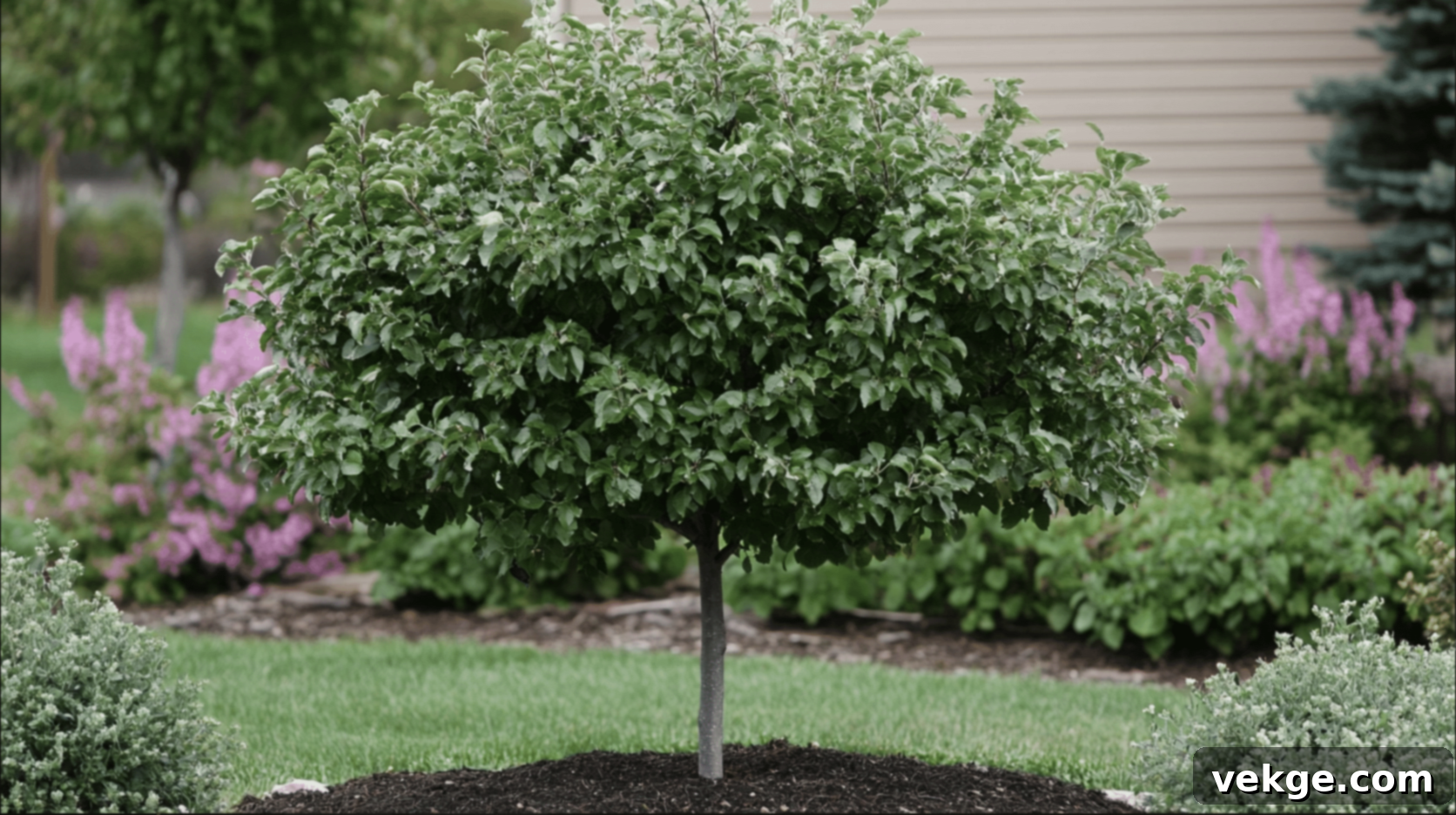
With an established root system, the tree now begins to focus on above-ground growth, forming its initial structure.
- Branching Out: The tree starts to develop its main scaffold branches, increasing in height and spread.
- First Blooms (Dwarf varieties): For dwarf apple trees, you might observe the appearance of the very first flowers during this period. While exciting, it’s generally recommended to remove these initial blooms (a process called “de-blossoming”) to direct the tree’s energy into vegetative growth and building a stronger framework for future fruit production.
- Training Begins: This is a critical time to begin training the tree to your desired shape through careful pruning, establishing strong branch angles and an open structure for good air and light penetration.
Years 3-5: Pre-fruiting and Initial Yield
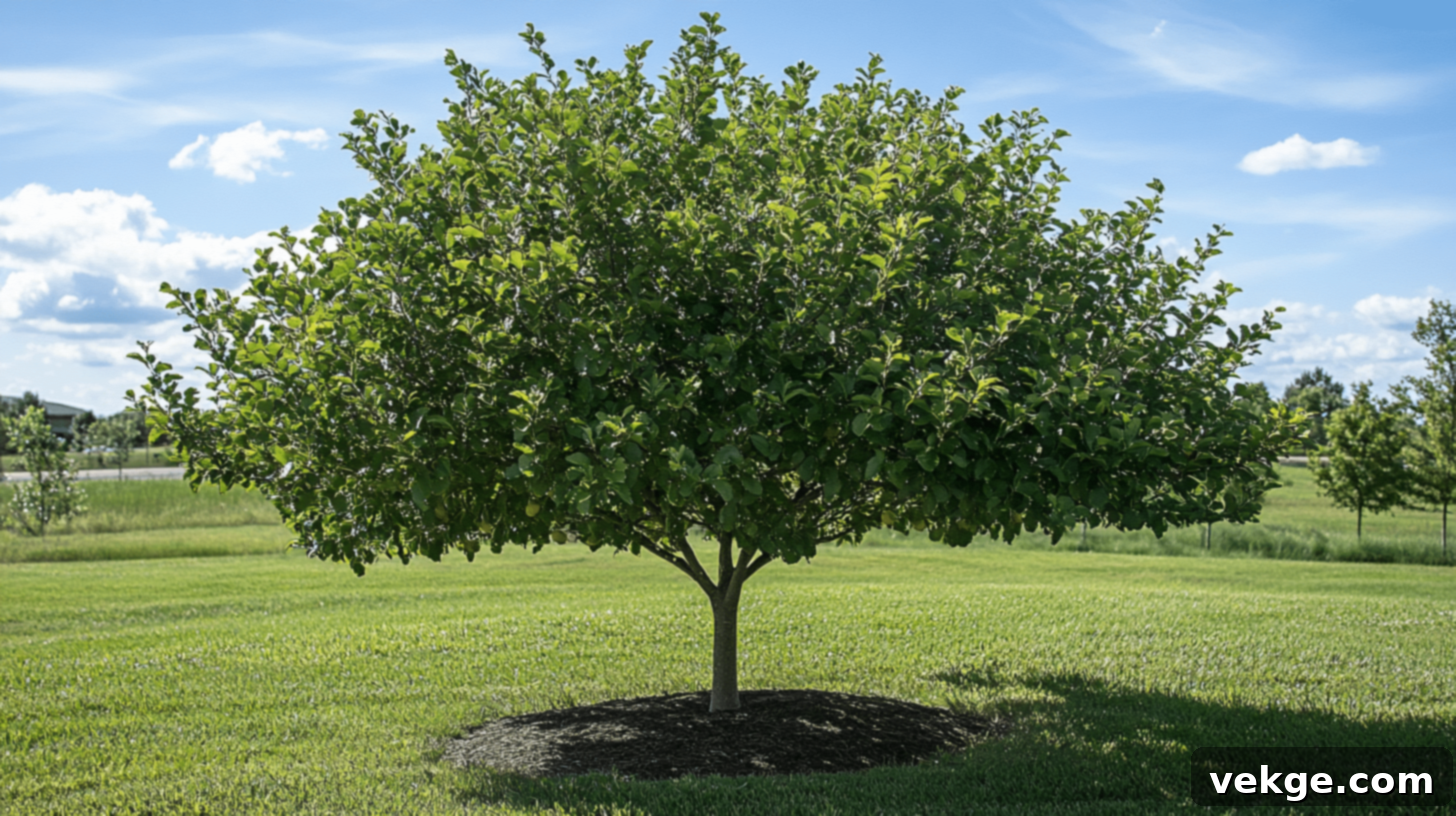
As the tree matures, it shifts its energy from purely vegetative growth towards reproductive development.
- Continued Growth: The tree continues to grow significantly in both height and spread, filling out its canopy.
- First Fruit (Dwarf and Semi-Dwarf): Dwarf and many semi-dwarf varieties will typically begin to bear their first significant harvest during these years. You’ll likely see more flowers, and if pollination is successful, small fruits will begin to develop.
- Standard Trees: Standard apple trees will continue to primarily focus on vegetative growth, building the large structure that will support their future abundant yields.
- Pruning Importance: Pruning remains crucial for maintaining tree health, promoting fruit-bearing spurs, and ensuring an open canopy for optimal sunlight and air circulation.
Years 5+: Maturity and Full Fruit Production
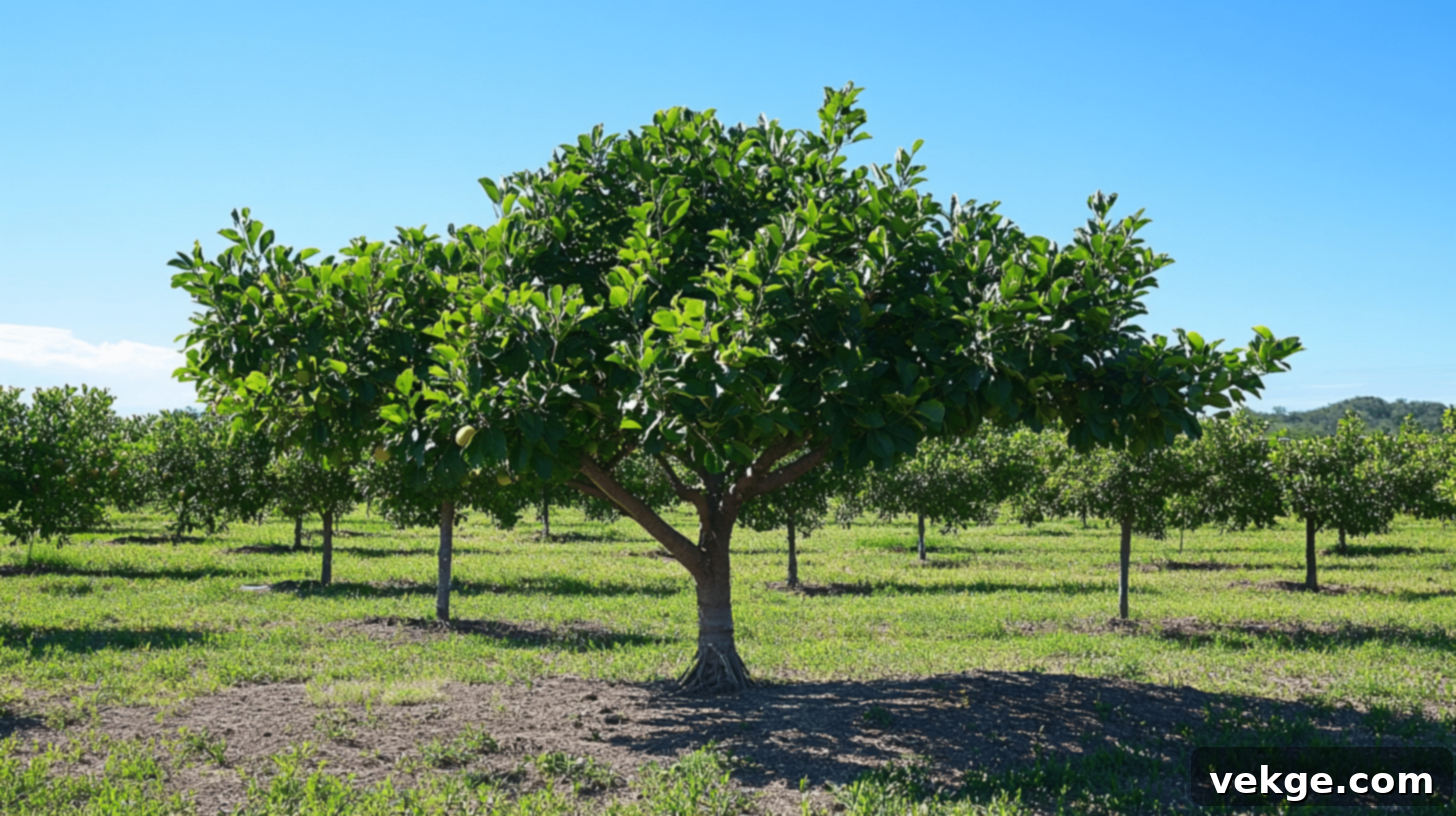
This period marks the tree’s entry into its most productive phase, offering consistent and often abundant harvests.
- Full Production: Most apple trees, regardless of rootstock, will have entered full fruit production by this stage. Standard trees, which are the slowest to mature, may finally begin fruiting consistently around years 6-8.
- Peak Size: The tree reaches its full mature height and spread (depending on the rootstock), forming a well-developed canopy.
- Routine Care: Annual pruning, regular fertilization based on soil tests, consistent watering, and diligent pest and disease management become routine practices to maintain vigor and productivity.
Years 10-50+: Productive Maturity and Decline

Apple trees, especially standards, can remain productive for many decades with proper care, providing a legacy of fruit.
- Sustained Yields: Trees continue to bear fruit annually, with fruit quality and quantity often peaking during their prime productive years.
- Dwarf Tree Decline: Dwarf trees, with their shorter lifespans, may begin to show signs of decline after 15-20 years, with reduced vigor and fruit production.
- Standard Tree Longevity: Standard trees, known for their longevity, can remain highly productive for 50 years or even more, becoming magnificent fixtures in the landscape.
- Aging Care: As trees age, pruning might focus more on maintaining tree structure and renewing older fruiting wood. Continued attention to soil health and pest management is essential.
It’s important to remember that these timelines are general estimates. The specific apple variety, the type of rootstock it’s grafted onto, the local growing conditions, and the quality of care provided will all influence how quickly your tree develops and when you can expect your first juicy harvest.
Cultivating Success: Essential Care for Productive Apple Trees

Once your apple tree is planted, consistent and attentive care is the bedrock of healthy growth and abundant fruit production. Mastering a few key practices will ensure your tree thrives for years to come. Maintaining healthy and productive apple trees is simpler than you might think if you focus on these essential areas:
1. Watering: The Lifeline of Your Tree
Proper watering is critical, especially for young trees and during dry spells, as it directly impacts fruit size and tree health.
- Deep and Regular: Water deeply and consistently, particularly during dry periods throughout the growing season (spring to fall). Aim to soak the root zone.
- Measure Moisture: Target approximately 1 inch of water per week, whether from rainfall or supplemental irrigation. Check soil moisture with your finger before watering; it should feel slightly damp but not soggy.
- Avoid Overwatering: While crucial, avoid overwatering, which can lead to root rot. Good drainage is key.
- Mulch Benefits: Apply a 2-4 inch layer of organic mulch (like wood chips or straw) around the base of the tree, keeping it a few inches away from the trunk. Mulch conserves soil moisture, suppresses weeds, and moderates soil temperature.
2. Fertilization: Feeding for Growth and Fruit
Nutrient supplementation supports vigorous growth and robust fruit development. However, excessive fertilization can lead to too much vegetative growth at the expense of fruit.
- Soil Test First: Ideally, conduct a soil test every few years to determine your soil’s specific nutrient deficiencies and pH. This guides your fertilization strategy.
- Balanced Approach: In early spring, before new growth begins, apply a balanced granular fertilizer (e.g., 10-10-10) or one formulated for fruit trees. Spread it evenly under the canopy, avoiding direct contact with the trunk.
- Organic Options: Compost, aged manure, and bone meal are excellent organic alternatives that improve soil structure and provide slow-release nutrients.
- Don’t Over-fertilize: Too much nitrogen can promote lush leaf growth but reduce fruit production. Watch your tree’s growth; if it’s growing vigorously, it may need less fertilizer.
3. Pruning: Shaping for Health and Productivity
Annual pruning is essential for maintaining tree health, promoting good air circulation, and encouraging fruit production.
- Timing: Prune annually in late winter to early spring, while the tree is dormant and before new growth begins.
- Remove the Three Ds: Always start by removing any dead, diseased, or damaged branches.
- Open Canopy: Prune to maintain an open center (for central leader or open vase systems) to allow sunlight penetration to all parts of the canopy and ensure good air circulation, reducing disease risk. Remove crossing or rubbing branches.
- Encourage Fruit Spurs: Identify and preserve fruit-bearing spurs (short, gnarled branches that produce flowers and fruit), and prune to encourage their development.
- Manage Height: Keep the tree at a manageable height for easier harvesting and maintenance.
4. Pest and Disease Management: Vigilance and Prevention
Regular inspection and timely intervention are crucial for preventing pests and diseases from impacting your harvest.
- Regular Checks: Frequently inspect your trees for any signs of pests (e.g., aphids, codling moth larvae, mites) or diseases (e.g., apple scab, powdery mildew, fire blight).
- Integrated Pest Management (IPM): Employ an IPM approach, which prioritizes cultural practices and biological controls over chemical sprays. This includes good sanitation (cleaning up fallen leaves and fruit), encouraging beneficial insects, and choosing disease-resistant varieties.
- Appropriate Treatments: If problems arise, use the least toxic effective treatments first. Consult local extension services for recommended controls for common issues in your area.
- Common Issues: Be aware of apple scab (fungal spots on leaves/fruit), fire blight (bacterial disease causing scorched appearance), and codling moth (larvae tunneling into fruit).
5. Fruit Thinning: For Larger, Better-Quality Apples
Thinning the fruit may seem counterintuitive, but it’s a vital step for producing larger, healthier apples and preventing biennial bearing (where the tree produces heavily one year and very little the next).
- Timing: Thin fruits when they are small, typically about the size of a dime (around 4-6 weeks after full bloom).
- Spacing: Leave only one or two of the largest, healthiest fruits per cluster. Space individual fruits about 6 inches apart along the branch.
- Benefits: Thinning allows the remaining fruits to grow larger and develop better flavor and color. It also reduces strain on branches, prevents breakage, and helps the tree conserve energy for setting fruit again the following year.
Remember, consistent and proactive care is the golden key to a bountiful and delicious apple harvest. By following these essential steps, you’ll be well on your way to enjoying the unparalleled taste of homegrown apples for many seasons to come.
Conclusion: Your Rewarding Journey to Apple Abundance
Growing apple trees is a truly rewarding endeavor, a journey that demands patience, observation, and dedicated care. From the initial excitement of selecting the perfect variety and preparing its ideal growing environment to the ongoing commitment of watering, pruning, and protecting your tree, each step brings you closer to the unparalleled joy of plucking a crisp, juicy apple directly from its branch.
Remember that apple trees, like all living things, operate on their own timeline. They require time to establish their roots, build a strong framework, and eventually, begin to bear fruit. However, with consistent attention to their needs – particularly proper watering, strategic pruning, effective pest management, and thoughtful fruit thinning – you will set the stage for many years of abundant, high-quality harvests.
The satisfaction of biting into a sun-warmed apple that you’ve nurtured from a tiny seed or a young sapling is an experience unlike any other. Beyond the sheer delight of fresh, organic fruit, you’ll also create a beautiful, productive, and enduring addition to your landscape, providing shade, beauty, and a continuous supply of nature’s candy. Your efforts will not only enrich your garden but also provide healthy, delicious food for your family and friends.
We invite you to share your apple-growing adventures with us! Feel free to post your experiences, tips, or any questions you might have in the comments section below. Happy growing, and may your baskets be overflowing with delicious homegrown apples!
Frequently Asked Questions (FAQs)
How Can I Encourage My Apple Tree to Produce Fruit?
To encourage fruit production, ensure your tree is well-pollinated (plant compatible varieties nearby), prune it correctly to promote fruiting wood and good air circulation, maintain proper nutrition through soil testing and balanced fertilization, and practice fruit thinning to encourage larger, healthier fruit and prevent biennial bearing. Most grafted apple trees need 2-5 years before consistently bearing fruit, with dwarf varieties fruiting sooner than standard ones.
Why Isn’t My Apple Tree Bearing Fruit?
Several factors can prevent an apple tree from bearing fruit. Common reasons include the tree being too young (standard varieties take 4-8 years), lack of proper pollination (most apples need a compatible pollinator), incorrect pruning (removing fruiting wood), nutrient imbalances, insufficient sunlight (at least 6-8 hours daily), or unfavorable weather conditions (late frosts damaging blooms). Assess these factors and adjust your care routine. Consider adding another compatible apple variety for cross-pollination if you only have one tree.
Can I Grow an Apple Tree from Seed, and How Long Will It Take?
Yes, you can grow an apple tree from seed, but it’s often a “genetic lottery.” The resulting tree may not produce apples like the parent fruit and could yield fruit unsuitable for eating. Seed-grown trees also take significantly longer to mature, typically 6-10 years or more, before bearing any fruit. For reliable results and quicker fruit production, purchasing grafted saplings from a reputable nursery is highly recommended.
